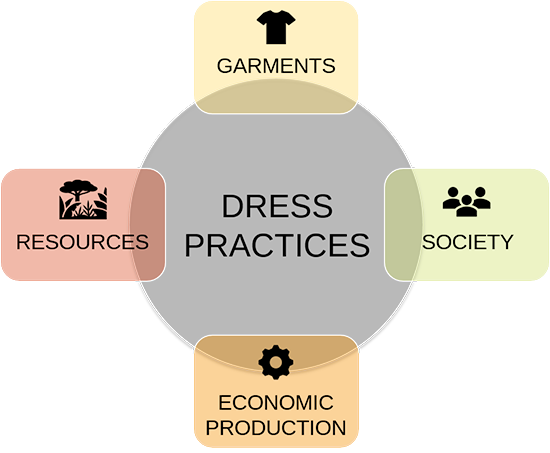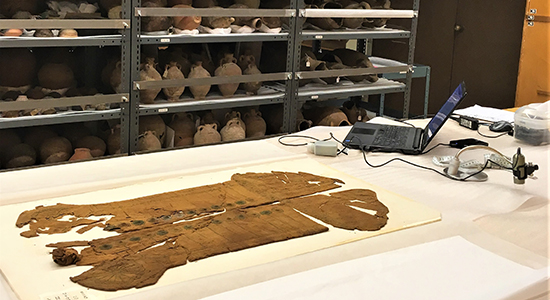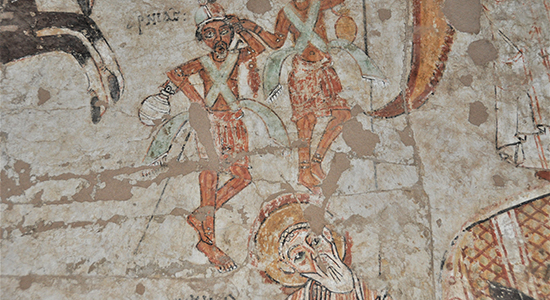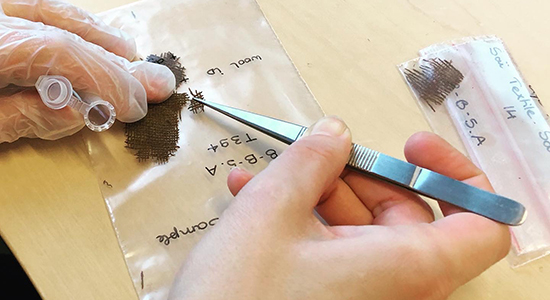Methodology
Fashioning Sudan sits under the wide umbrella of entanglement and materiality theories, considering garments at the cross-section between three spheres: raw material, technology, and society.
From artefacts to interpretations, the team will follow the material from fibre to cloth, from clothing to clothing practices in a 6-steps method:
- Building infrastructure (relational database, textile-skin-clothing terminologies, categories & concepts), integrating new theoretical debates on multiple ontologies and the decolonisation of cultural heritage.
- Extensive data collection to gather all information pertaining to textile and skin artefacts (e.g. material, craft techniques, date, shape, context).
- Data statistical analyses to reveal the geographical distribution and evolution of diagnostic traits.
- Results interpretation using frameworks from economic theories and communities of practice, developing case-studies discussing site-catchment analyses, production, and exchange geared toward non-subsistence items.
- Wardrobe study: database (part2/dress assemblages) merging archaeological, iconographic, and textual sources; individual items and garment combinations; investigation of different body concepts and sensory assemblages; GIS map of dress practices with timeline.
- Series of case-studies: stemming from semiology and mediation theory, garments will be examined as a multi-vectoral mode of communication and help reframe the notion of past identities. Depending on each of the case-studies, we will explore diverse narratives of identity, focusing on either one aspect or on the multi-layering of identities: gender and age, social status, body and personhood in life and death, regionality, and individual vs. group identities. These individual cases will finally be combined and compared to the rest of the data to form a diachronic overview, potentially able to determine patterns emerging in specific regions and periods and drawing a dynamic understanding of diverse identities through time and space.

Because garments are made of diverse material and touch upon so many diverse aspects of past experiences, the project will adopt an interdisciplinary approach merging the humanities with natural and socio-cultural sciences, combining archaeological and craft studies, fieldwork in museums and excavations, biochemical analyses, archival study, and theoretical questioning.
It will draw upon the following:
Fashioning Sudan is conducting the analysis of hundreds of unpublished archaeological textiles. It first focuses on the identification of animal and plant species used for the production of textile fibres (microscopy and SEM imaging for flax, cotton, and potential wild grasses, and palaeoproteomics for wool). Combined with previously-acquired data on textile tools, the project documents spinning, weaving and tailoring techniques to reconstruct the textile chaîne opératoire. A crucial step consists of establishing criteria to recognise garments from fragmentary assemblages and create a new classification, leading to an inventory of the Sudanese wardrobe and associated concepts (e.g. loincloth, apron, skirt, tunic, trousers/hidden vs. visible, minimalist vs. decorated). Comparing data from textiles and iconography, the project explores the correspondences and discrepancies between images and known dress types, as they seem to indicate different political strategies of sartorial display and material redistribution.
Skin research follows a similar trajectory and is, for the first time, considered on a much broader geographical and chronological scale. It first focuses on identifying the wild or domesticated animal species (e.g. sheep, goat, cattle, dromedaries, gazelle, leopard and giraffe?) used to produce skins and hides, using microscopic morphometric observations and palaeoproteomics. Together with multi-spectral imaging, these techniques documents the chaîne opératoire of skin production by studying the raw material and processes used for tanning, dressing and colouring the skins, as well as the tailoring techniques (e.g. cutting, sewing, appliqué).
Based on ancient protein sequencing and peptide mass fingerprinting (PMS or “ZooMS”) by mass-spectrometry (MS), palaeoproteomics provides reliable identification of the biological species used as source material for garment production. Fashioning Sudan harnesses the great developments made in this field over the past few years, and will contributes significantly in its establishment in the Nile valley region. Completing our knowledge on collagen proteins present in skin and leather, the project also focuses on developing the available reference databases for keratin proteins present in animal hair and wool. It offers great development potential for this method, providing samples from both domesticated and wild species from a little-referenced region. Together with textile and animal skin research, palaeoproteomics can reveal the deep relationships between the ancient populations of Sudan and Nubia and the animal world.
In addition to studying the general historical context of ancient garments, Fashioning Sudan focusses on selected domains closely linked to their production and use: 1) funerary archaeology for recording the specific burial gestures associated to garments; 2) the archaeology of craft practices for documenting the organisation of the production and build a comprehensive background to the garments under review; and 3) experimental and digital reconstructions of garments to understand their use on the body. Archival studies retraces the historiography of museum pieces, while partnerships with ongoing excavations are leading to the better recording of in-situ finds. The project will conduct a series of high-precision AMS radiocarbon dating, leading to the establishment of a well-founded chronology of dress types. From a wide data collection campaign, the team is compiling a relational database of garments and iconographic and textual mentions of garments, which will lead to a diachronic map of dress practices in ancient Sudan.



